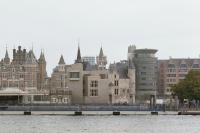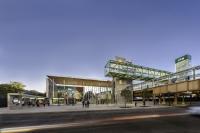Sansibar by Breuninger
Stuttgart , Germany
DIA – Dittel Architekten are overseeing the design and architectural implementation of Sansibar by Breuninger in the new Dorotheen Quartier in Stuttgart. The restaurant is a cooperation between fashion and lifestyle company Breuninger and Herbert Secklers cult restaurant on Sylt island. The aim of the design concept is to surround the guest with the relaxing lifestyle of the northern island in the midst of the new quarter. Atmospheric colours and typical island materials are placed in an urban context to create a unique space concept and feel-good location. DIA – Dittel Architekten were also behind the very first implementation of Sansibar by Breuninger in Düsseldorf.
An extension to the fashion house with its two opposing entrances, Sansibar by Breuninger connects Karlspassage to Dorotheenplatz during store opening hours. With 377 seats in the indoor and outdoor areas and occupying 756 square metres, the restaurant will be the flagship of the new quarter even after the store has closed.
Strikingly designed and stunningly lit, the bar in the centre is a magnet for anyone entering the restaurant. Open on four sides it connects all of the areas together and creates multiple vantage points. The noble Jura slate body blends perfectly with the flagstone bar, which flows into the dark oak wood centrepiece via a brass strip. Mounting in a wave-like fashion, the custom-made designer lights contrast with the angular feel of the assertive bar.
The key material behind the concept is wood; together with sea blue, sandy and golden tones it speaks the language of the island’s vast dunes and maritime climate. The theme is interpreted and developed in different ways across three sections: the lounge with a row of inlaid seating, hut area and fine dining. The zones are spread across two different floor levels and have varying ceiling heights as well as alternating laying directions for the fishbone parquet flooring with frieze around the edges. The areas are subtly partitioned with light-toned room dividers in a fishing net structure and the window façade on the one side, which separates the light and airy from the snug and cosy area.
Down at the bar level there is a spacious lounge reminiscent of a dune-filled landscape with its sandy golden tones and green velvet cushions. It provides comfortable seating in good company, a fantastic view of the room and adjoins a sustainable wall made from pressed natural materials. At the neighbouring row of seating in front of the façade, guests can soak in the light-flooded space with its five-metre-high ceilings or watch the world go by on Dorotheenplatz. An undulating curtain installation accentuates the height of the room and by night serves as an illuminated focal point from the outside. Light oak furnishings and colours add to the welcoming atmosphere.
The entry to the hut area is marked by a change in floor level and dominating dark oak wood. Solid circular wooden tables merge with protuberant basket-shaped lamps to create an ambience of safety and privacy. The eleven-metre-long “wooden hut”, with its reclaimed wood frame and laminate flooring, epitomises this feeling. An effective combination of different colour nuances, the wooden trims of the back panel are particularly noteworthy. The smooth, sandy-coloured wall pays further homage to the dune-filled landscape, its horizontal backlit waves creating a dynamic effect. Furnishings in orange and green hues create colour contrasts with the predominantly earthy tones.
The fine dining area is home to a modern interpretation of the wicker beach chair. Framed in subtle beige, with light oak wood panelling on the interior surfaces, blue upholstery and marram grass, the banquet booths present an inviting and pleasant place to sit. The graphic structure of the wall rack, made from reclaimed wood and black steel and showcasing Sansibar-branded products, makes it a real focal point and accentuates the height of the room. Winding their way throughout the restaurant, lovingly thought-out graphic design elements including wall art, signage and menus lend the finishing touch to the restaurant.
From outside, the illuminated Sansibar logo is visible from a distance. The entrance creates a striking contrast with brass and reclaimed wood panelling. A continuation of the material concept, oak and teak wood are the predominant furnishings for the outdoor terrace. At the heart of Dorotheenplatz, it offers seating for 100 guests and is protected by a canopy roof extending in large waves right the way along the annex to Eduard’s lifestyle bar, also incidentally designed by Dittel Architekten.














